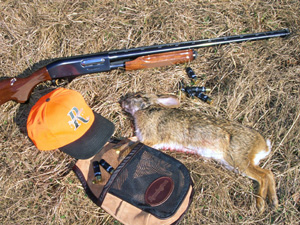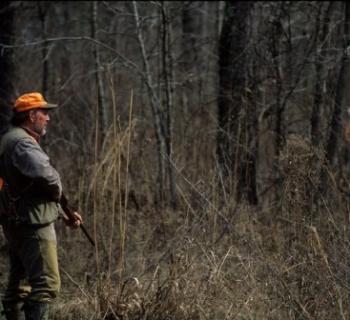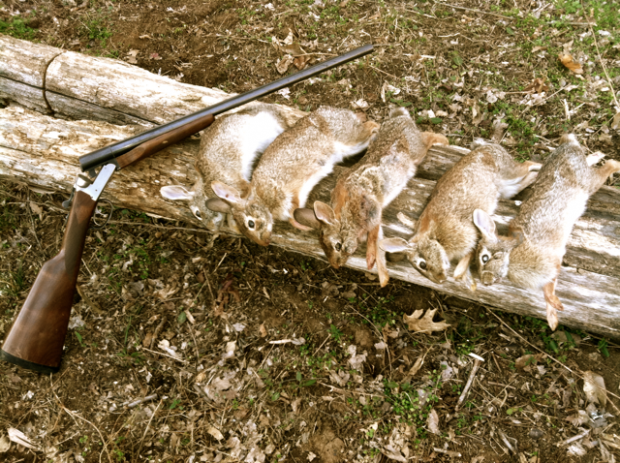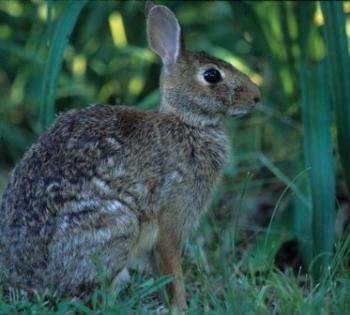Matt Walker is a former graduate research assistant that conducted rabbit research at Mississippi State University.
As the air turns cooler and fall progresses, hunters across Mississippi eagerly anticipate the opening day of their favorite hunting season. Many hunters consider rabbits to be one of the most challenging and rewarding small game species (especially at the dinner table). Some hunters enjoy kicking along a fencerow alone, eager to jump a rabbit, while others prefer the thrill of watching a pack of dogs scurrying after a fleeing rabbit. Whatever your rabbit hunting approach, hopefully this article will give you some helpful hints to increase your rabbit hunting success.
The most obvious requirement for a successful rabbit hunt is finding out where the rabbits are. Cottontail rabbits prefer brushy cover for protection in upland agricultural fields and grasslands, and reach their highest populations in areas that provide a patchwork of several usable habitat types. As their name implies, swamp rabbits are associated with wet areas, preferring moist  lowlands and brushy cover along streams and ditch banks. Don’t forget your briar pants because the thickets rabbits prefer are filled with various types of thorns. It is also important to wear as much hunter orange as possible to increase human visibility in these densely vegetated areas.
lowlands and brushy cover along streams and ditch banks. Don’t forget your briar pants because the thickets rabbits prefer are filled with various types of thorns. It is also important to wear as much hunter orange as possible to increase human visibility in these densely vegetated areas.
Many hunters know that fencerows often harbor rabbits, but don’t forget to check brushpiles, fallen trees, and even wooded areas. Several hunters simply do not realize that woods provide sanctuary to a horde of rabbits, and these areas generally receive less hunting pressure. Also, don’t forget to ask a farmer for permission to hunt his agricultural fields. Rabbits often feed here, and the farmer likely would appreciate help controlling local rabbit populations that may harm his crop.
One of the most overlooked secrets of rabbit hunting is scouting. Cottontail rabbits are highly active at dawn and dusk and this is usually when most rabbits can be seen. Pay special attention to where and how the rabbits flee because these escape routes are used repeatedly and may be useful in the future.
Now that you know where to hunt, we will examine what to hunt with. In thick cover it is recommended to use a shotgun with an improved cylinder choke and No. 6 or 7 shot. Because shot distance is limited in heavy cover, close shots are usually taken quickly where a wide pattern with heavy shot is beneficial. However, some hunters prefer to use a modified or full choke when hunting with dogs to make sure no stray shot brushes a dog. A tighter choke with heavier shot such as No. 4 will allow for longer shots.
Another important factor is determining when to hunt. Cold, damp days provide the best days for rabbit hunting. Rabbits often take shelter somewhere hidden from the cold and the wind with easy access to open areas where they can absorb body-warming rays of sunshine. The first warm day after a cold snap often provides good hunting. Try to cover your human scent as much as possible and stay downwind of the rabbit.
 Low humidity and dry ground are two variables that may lead to having a poor hunt. Dry air tends to dry the dogs’ noses, making them less likely to absorb scent particles, and dry ground doesn’t hold scent well either. Strong winds also discourage rabbit movement and may make them harder to find. Hunting after a few good frosts will increase visibility and reduce rabbit cover.
Low humidity and dry ground are two variables that may lead to having a poor hunt. Dry air tends to dry the dogs’ noses, making them less likely to absorb scent particles, and dry ground doesn’t hold scent well either. Strong winds also discourage rabbit movement and may make them harder to find. Hunting after a few good frosts will increase visibility and reduce rabbit cover.
The most common mistake made by rabbit hunters can be easily corrected–Slow Down!!! Humans and dogs both seem to think that covering more ground increases hunting success. Dogs and humans both miss rabbits holding tight to their hidden position even when in close proximity. Moving more slowly and performing a more thorough search of the area would likely flush a rabbit and provide a shot.
A couple of rabbit hunting tricks may be helpful. When rabbits flee, watch them into the distance where they often stop and look back to see if danger is out of range. This may provide the perfect time for bagging the rabbit. Another trick is whistle or click your tongue when the rabbit takes off. This will often cause a rabbit to stop and try to decipher what and where the sound is.
While this article may be of little use to the seasoned professional, it may provide beginners some helpful tips on how to increase rabbit hunting success. Rabbits provide a difficult shot, a race for the dogs, and overall excitement for the hunter. Don’t forget to involve children, as hunting provides hours of recreation for people of all ages. May the conditions be great, and the rabbits run freely!
